

AxErd Home. Accounts Receivable Analysis. Using KPIs to Improve Collection Performance. Tracking the traditional accounts receivable metrics is a good start, but they don’t provide enough insight to guide you to what actions to take to improve your cash flow.

The traditional metrics to which I am referring are important indicators of overall revenue cycle and accounts receivable health: Total Outstanding Accounts Receivable – Identifies how much cash do you have invested in uncollected charges. Accounts Receivable Aging – Measures the delay in collecting these charges. Financial Ratios and KPI Examples. Key Performance Indicators - ACA International. In today’s collection environment, everyone is trying to do more with less.

Using key performance indicators correctly can be a simple and effective way to keep your business on track. At the “Boost Your Business with Key Performance Indicators” session at ACA International’s 74th Annual Convention, instructors Nick Jarman and Roger Weiss discussed how to best use KPls. “Truly, the essence of using KPIs is, ’How are we doing in certain areas?’” KPI Checklist. Examples of KPI for Accounting Department. Essential Accounts Receivable Key Performance Indicators (KPIs) What are you Debtors really costing you? The Customer Value Group - Products & Solutions - CVG Value+ Accounts receivable. BI: Download LOB & IT Free Kit - PPC. Key Performance Indicators - Sample KPI's. Sources and Uses of Accounts Receivable. Chapter 7: Accounts Receivable The purpose of this chapter is to examine how accounts receivable affect businesses, how they are controlled, accounted for, and reported in financial statements.
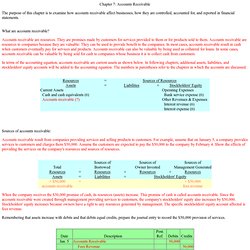
Analyzing the Factors that Affect Your Cash Flow. Accounts receivable, average collection period, accounts receivable to sales ratio--while you might roll your eyes at all these terms, they're vital to your business.
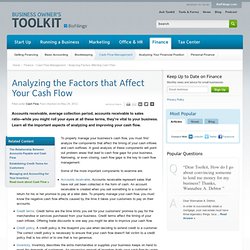
Learn all the important aspects of analyzing and improving your cash flow. To properly manage your business's cash flow, you must first analyze the components that affect the timing of your cash inflows and cash outflows. A good analysis of these components will point out problem areas that lead to cash flow gaps for your business. Narrowing, or even closing, cash flow gaps is the key to cash flow management. Updating Accounts Receivable Statistics for Customer Analysis.
The system stores the DSO amount at the periodic level in the F03B16.

You can use these methods to calculate DSO: Using the countback method, if the current outstanding balance is less than the total sales, the DSO = (current balance ÷ total sales) à number of days in the period. Otherwise: Subtract the current period's total sales amount from the current balance and increment DSO with the number of days in the period.Subtract from the remaining balance the total sales of the first preceding period.This continues until the outstanding balance of any preceding period exceeds the remaining balance.If the remaining balance is less than the preceding period, then DSO = Accumulated DSO + ((current balance ÷ total sales) à number of days in period).
Interpretation of financial ratios. SAP Materials, Documents, Tutorials. Credit Key Performance Indicators (KPIs) In the world of credit management, often your receivables team have many key performance indicators (KPIs) to choose from, whether they are direct or indirect measurements of recovery on receivables.
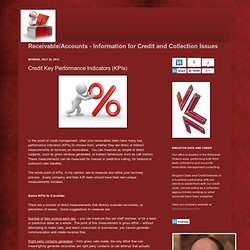
You can measure as simple or direct subjects, such as gross revenue generated, or indirect behaviours such as call metrics. These measurements can be measured for manual or predictive calling, for inbound or outbound calls handled. The whole point of KPIs, in my opinion, are to measure and refine your recovery process. Every company and their A/R team should have their own unique measurements installed. Accounting Application. Accounts Receivable (FI-AR) - Service Level Management. 14 Reasons to Focus on Receivables Management in 2014e2banytime Blog. There is only one thing worse than not making a sale: making a sale and not getting paid, which happens quite frequently for many companies.
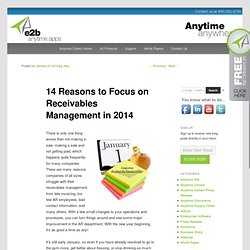
There are many reasons companies of all sizes struggle with their receivables management, from late invoicing, too few AR employees, bad contact information, and many others. With a few small changes to your operations and processes, you can turn things around and see some major improvement in the AR department. With the new year beginning, it’s as good a time as any! It’s still early January, so even if you have already resolved to go to the gym more, get better about flossing, or stop drinking so much coffee this year, you still have time to squeeze in one more resolution. Accounts Receivable Management : Developing Accounts Receivable KPIse2banytime Blog. Key performance indicators (KPIs) are useful for developing credit and collection plans.
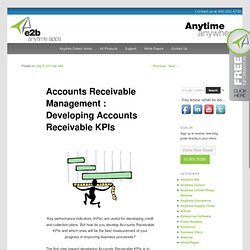
But how do you develop Accounts Receivable KPIs and which ones will be the best measurement of your progress in improving business processes? The first step toward developing Accounts Receivable KPIs is to analyze your existing customer accounts and accounts receivable data. This historic information will help you see which areas should be targeted for improvement. Articles About Cash Flow Analysis & KPI Management. If you had to settle on one measure to monitor your company’s need for capital, this would have to be it.
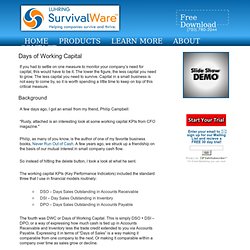
The lower the figure, the less capital you need to grow. The less capital you need to survive. Capital in a small business is not easy to come by, so it is worth spending a little time to keep on top of this critical measure. Background A few days ago, I got an email from my friend, Philip Campbell: “Rusty, attached is an interesting look at some working capital KPIs from CFO magazine. " Philip, as many of you know, is the author of one of my favorite business books, Never Run Out of Cash. So instead of hitting the delete button, I took a look at what he sent. Accounts receivable KPI. Accounts receivable KPI Types of Accounts receivable KPIs 1.

Total monetary value of overdue invoices. 2. Sum of monetary value of unsettled i.e. unpaid invoices. 3. 4. 5. 6. 7. 8. 9.